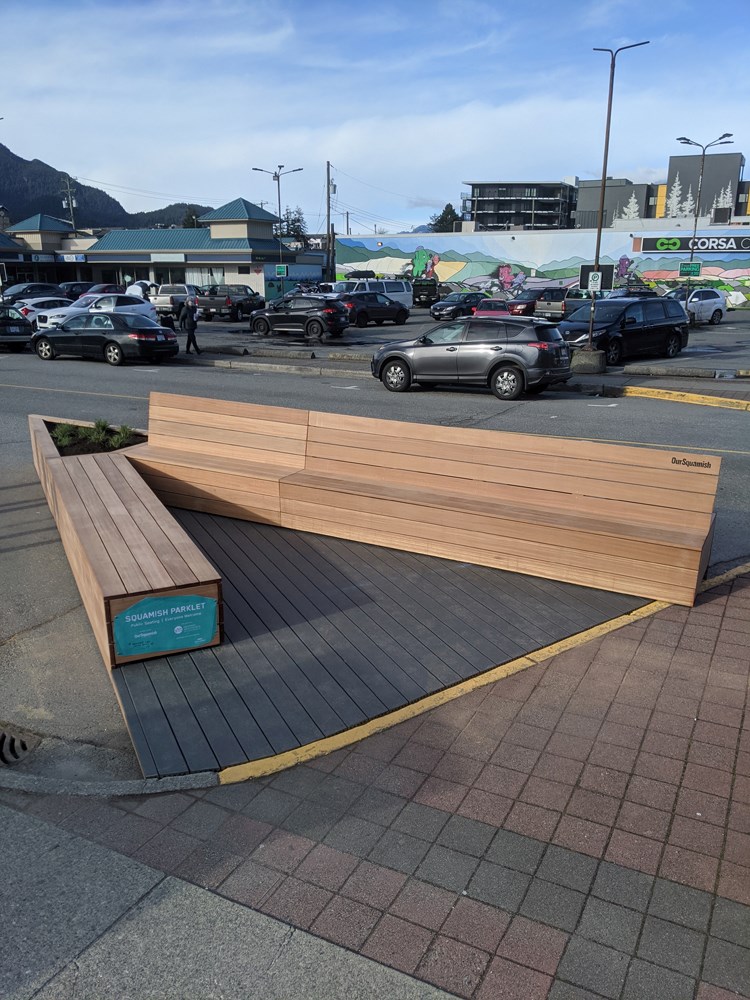Recently, when a new seating area by nonprofit OurSquamish took up a parking spot, many in town decried the loss of a car space.
A perceived lack of parking isn’t a new complaint. This issue has been raised in our pages and on online forums for years now, as Squamish has grown.
But we need to start thinking about parking and our right to it differently.
One thing we can likely all agree on is that regional transit and a more frequent bus system would help, as would more biking infrastructure to make it safe for riders — and rollers — of all ages to get around town.
Todd Litman, who literally wrote the book on city parking ( Parking Management Best Practices) and founded the Victoria Transport Policy Institute, noted parking complaints are not unique to Squamish.
“Most people in their whole life never purchase a parking place as a separate asset or product. It is always bundled with other things or financed indirectly, so motorists have become accustomed to expect that they have a right to a parking space — to abundant, convenient parking,” he told The Chief, adding that usually there are several parking places per car in a community.
“It is like fish can’t see water; there’s a bunch of parking out there, but people fight over the most convenient ones.”
Developers provide parking as part of their building or the municipality does.
People think of the benefits of ample parking, but not about the costs, he added.
“It is funny because most motorists are perfectly nice, polite people.... but when it comes especially to parking and congestion problems, from a policy perspective, they are incredibly selfish,” he said, noting that most citizens support affordable housing in principle, but will protest parking variances that make that housing more affordable.
“They are literally saying the convenience of my parking is more important than housing for people.”
He said there are parking solutions, but the problem has to usually get severe enough that folks are willing to think about alternatives.
He said instead of it being subsidized, parking needs to be paid for and managed better.
One solution is shared parking spaces.
Often churches, schools and offices have parking that is not being used at certain times — evenings, for example.
Every landowner could be encouraged to share their parking spaces when not in use.
Pay parking is another solution, especially with new smart apps that make it more convenient and efficient than coin parking meters
“When parking is unpriced, consumers have little incentive to ration their use, for example, by walking, cycling, ride-sharing or using public transit when possible to reduce parking demand. As a result, parking congestion problems are virtually unavoidable and total parking costs increase,” reads the website for the Victoria Transport Policy Institute.
“Paying directly rather than indirectly for roads and parking tends to be more efficient and fair overall.”
Litman notes that there are legitimate situations where quick and accessible parking is needed — such as for delivery drivers and at doctors’ offices or pharmacies.
“That is a higher priority use, so by all rational planning, you should either regulate or price to favour those higher uses,” he said.
Pay parking also generates revenue.
Another strategy to deal with parking is called parking cash-out, where travellers are rewarded for not using an available stall, with, for example, a free bus pass.
One more significant option, floated by former mayor Patricia Heintzman in the last council would be a parkade under the Mamquam Blind Channel park — where the Xwu’nekw Park and Canoe Shelter are — with about 280 to 300 stalls under there.
This could be built when the planned new sea dike is constructed.
As Heintzman said at the time, the city wouldn’t have to buy the land, saving millions. There was $470,000 in the District’s ‘Off-Street Parking Reserve’ at the end of 2019, according to District staff. (Latest amount to be calculated in May.)
When fossil fuel cars go the way of buffets in a pandemic, these stalls could be re-purposed for electric vehicle charging stations — or as an indoor skatepark?
No matter how you — er — park it, this issue isn’t going to be quick, or free.
As drivers and residents of Squamish, we need to start thinking about what our car culture costs us, as much as what it brings us.
What do you think about parking in Squamish? Send a letter to the editor to [email protected].



